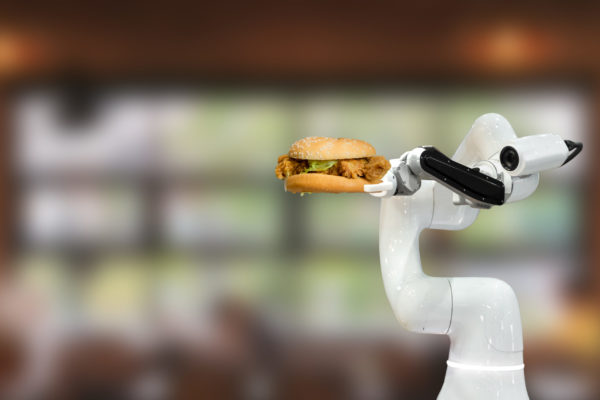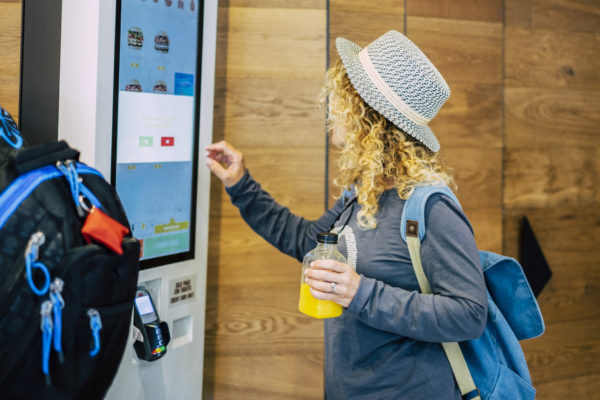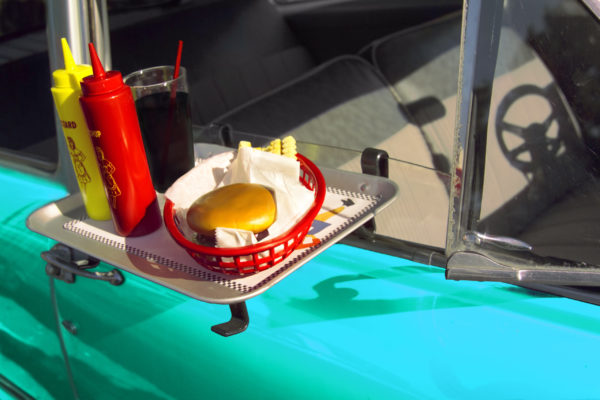The idea behind fast food is simple: Get customers their orders as quickly as possible to maximize profits. This concept is leading to significant innovation throughout the industry, as fast-food chains look to move customers in and out even quicker by streamlining the ordering and production processes. Let’s take a look at the future of fast food.

Many fast-food restaurants continue to prioritize drive-thru and mobile ordering. They’re also focused on building smaller buildings that operate more efficiently. Here’s what might be in store soon:
Drive under the restaurant
The concept of the “suspended kitchen” is making waves in the fast-food industry. Basically, the proposed layout is a kitchen and possibly a dining room that is suspended above the drive-thru lanes underneath them. Food would be delivered to drive-thru customers using a conveyor belt or proprietary lift system, allowing for a contactless transaction.
So far, Taco Bell and Burger King are forging ahead with this innovation, which could be great for saving space in urban areas.
Fry-making robots
Automation in fast food kitchens isn’t new but the technology is really improving behind the scenes. For example, White Castle, a fast-food burger chain that launched in 1921, is stepping into the future with fry-cooking robots. As part of a partnership with Miso Robotics, White Castle has introduced Flippy 2 to 100 of its locations.
Flippy automates the more technical parts of cooking fries and leaves human workers to handle quality-control and customer-facing work while sparing them the safety hazard of standing over hot grease.
Digital ordering

Ordering inside a fast-food restaurant has been done with an employee at the counter for decades.
The future of fast food could see this concept change considerably, though, as digital ordering becomes more standard. Instead of going inside the location and speaking with an employee, many fast food locations, including McDonald’s, KFC, and Taco Bell, have self-serve kiosks that let you order using a touchscreen.
Mobile ordering is also changing just how fast you can get your fast food, as it allows you to order it on an app before you arrive at the restaurant so that it’s ready when you get there. Mobile-only drive-thru lanes and waiting areas are becoming standard for most chains throughout the country.
Another innovative concept for saving customers time is bellhops. Chick-Fil-A is notorious for using bellhops in their drive-thru lanes, in which employees stand outside and take orders before cars get to the ordering intercom.
The return of the drive-in

Sometimes, what’s old is new again! The first drive-in restaurant, Kirby’s Pig Stand, opened in Dallas, Texas, in 1921. Drive-ins then became super trendy in the 1950s and 60s.
Drive-ins fell by the wayside when the modern drive-thru rose to prominence in the 1970s and 80s, but they’re making a comeback as customers see value in having their food delivered to their vehicles.
Burger King is one chain that’s putting a new, environmentally-friendly spin on the classic drive-in experience with a new concept that has the chain building solar-power canopies and allowing customers to park there while placing orders through the company’s app. Sweetgreen is also exploring a drive-in concept with concierge service and in-car dining.
Are you excited about the future of fast food?
Fast-food chains are clearly innovating but it remains to be seen which elements will become permanent fixtures in their food delivery systems. We live in a world with an increased focus on contactless service, though, which is one reason restaurants are trying these ideas.
What do you think of these innovative concepts? Are you excited about any? Let us know in the comments section and share this post with the foodies around you!